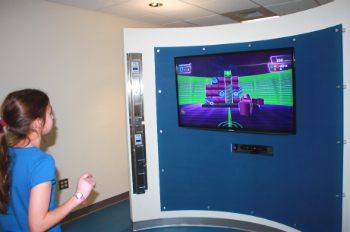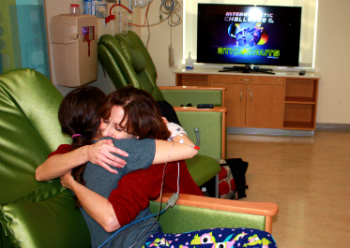WASHINGTON, D.C. — Shortly after her 13th birthday, Dani Zimmerman started to feel pain in her fingertips that quickly spread to three of her limbs. The pain was excruciating, she said. Her doctors soon diagnosed her with Reflex Sympathetic Dystrophy, a nerve disorder characterized by chronic burning pain.

One of those techniques involves video games.
The countless hours children and teens spend playing on video game consoles, computers or cell phones are often a distraction from homework, exercise or face-to-face interaction. But at Children’s National the distraction provided by these games is key to treating Dani and other young people suffering from chronic pain.
Wednesday, the Sheikh Zayed Institute for Pediatric Surgical Innovation at Children’s National, with the support of a single private donation, officially opened the Pain Medicine Care Complex. The Complex is among a handful of programs nationwide that focuses only on pain management for children of all ages. Dr. Sarah Rebstock, programs director at the Complex said that through this new initiative, we will see “pain medication practices for pediatrics [become] accessible all over the U.S. and world, treating patients with individualized medicine then using data to individualize care.”
The Complex uses cutting edge technology and tools to treat children with a range of chronic ailments, such as sickle cell disease, fibromyalgia and HIV. Therapy based on video games and electronic information-gathering help medical professionals measure short- and long-term patient progress, according to Children’s National. This approach helps kids overcome pain while allowing doctors to measure — and improve treatment of — pain.
Currently, hospitals and pediatrician offices across the country use a spectrum (happy to sad, one to 10 and so on) to measure a child’s pain level. With the Complex, Children’s National will be able to treat young people based on objective data about what kind of pain they are experiencing, and how severe it is, said Christy Baxter, clinical manager at the Complex.
The Complex’s “multi-sensory room” allows chronic pain patients to play interactive video games, specially designed for the Complex, that are meant to distract, but also serve to increase range of motion and patient’s strength, said Baxter. While patients play, physical therapists use proprietary software to gather data, measure and ultimately treat pain.

Youth service professionals can also use many of the Complex’s techniques when working with children suffering from chronic pain — explaining the practices first, and gaining the child’s trust and belief in the process, Rebstock said. Creating a non-threatening environment, using interactive video games, validating the child’s pain, listening to music as a relaxation technique or simply offering to help can all be beneficial. If the child has an Individualized Education Program or 504 Plan, the worker and educational professionals should consider how pain management techniques can be integrated into the school’s support system.
Now, for the first time in over a year, Dani is pain-free and able to hug her mom. “Pain medicine is one of the most undertreated medical areas, particularly in children’s medicine,” Rebstock said. The Complex hopes to change that by helping child patients, like Dani, overcome their pain through advanced technologies, a holistic approach and unique interactive techniques.





























